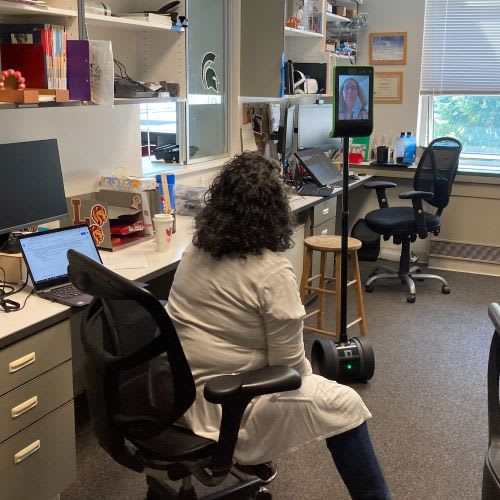More on Lakeside’s Robots

Learn more about the technology team’s resources for students and teachers, including who gets to use the robots, in this interview with Director of Technology Jamie Britto.
You might remember my test-drive of Lakeside’s robots from earlier this year; if so, when the new school year begins, you won’t be surprised to see the small platoon of rectangular-faced Segways parked in a neat formation at the Upper School Grotto, ready to roll into classrooms. Over the summer, the tech department has been stocking up on their fleet of Double 3 self-driving robots, upping the number from 2 to a whopping 26. The telepresence robots will be avatars for students unable to attend class in person.
Through Lakeside’s Summer School Programs, several students and teachers have already been using Double 3s in the classroom, and have given overwhelmingly positive feedback. I was also fortunate enough to try it out in one of my classes. The main advantage of using the Double 3 is the visual perspective. While taking remote classes over Zoom, I sometimes felt like a security guard passively watching a video feed of the classroom. Attending class in the Double 3, however, plunked me down in the middle of the room as if I were physically present. I could easily turn and talk to tablemates, and, if I felt adventurous enough for an odyssey, steer over to a neighboring table to say hello. Other students using the Double 3 had similar experiences — they felt more connected to the classroom and could more easily interact with their peers and their teacher.
Taylor Kempf, Upper School technology support, says that students attending class on the Double 3 benefits teachers too. Mr. Kempf notes that “students had the autonomy to be able to move themselves and participate in groupwork.” Telepresence was more convenient for teachers, who no longer needed to run conference calls on Teams or Zoom. Teachers could also drop their worries about whether remote students were picking up audio properly, and forego their habits of turning around mid-lecture to check for remote students’ reactions on the front screen.
Besides the fleet of Double 3s, the tech department also has a Kubi, a table-bound rotating telepresence apparatus. The Kubi has the additional advantages of stability and a simple student interface. When compared to the Double 3, the Kubi is a cost-effective solution, but cannot move around inside the classroom. The tech department plans to use the Kubi as a backup telepresence solution.
Whenever I work with telepresence robots, I am always struck by the innovative new technologies of today’s world. As Lakeside students, we are fortunate to have the opportunity to experience the forefronts of telecommunications. The imminent school year may be affected by the uncertainty of the Delta variant; however, with the support of Lakeside’s teachers and tech team, we can face this uncertainty with the mindset to adapt and develop innovative solutions.
